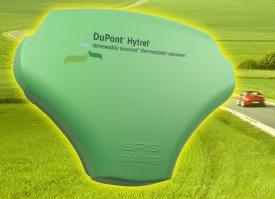Nov 11 2010
Joint development work between Takata-Petri of Aschaffenburg, Germany, and DuPont has resulted in the launch of a new grade of DuPont Hytrel RS, the industry's first renewably-sourced thermoplastic elastomer for use in airbag systems.
Replicating the technical properties of the standard grade of Hytrel used for such applications, including consistent physical properties over a wide range of temperatures, the material contains a minimum of 35 percent renewable content by weight derived from non-food biomass, thereby addressing auto manufacturers' needs for sustainable solutions.

For over 15 years, DuPont has supplied Takata-Petri, a leading manufacturer of innovative occupant safety systems, with petroleum-based Hytrel DYM polymers for use in the driver and passenger airbag covers of various OEMs. As the partnership between the two companies has strengthened, so has their determination to provide best-in-class airbag systems based on high-value and environmentally sustainable material solutions. It was as a reflection of this initiative that the two companies set out to develop a new grade of renewably-sourced Hytrel with comparable performance to Hytrel DYM in terms of low temperature ductility combined with high stiffness and good long term aging performance, as well as ease of processing and good paintability.
The newly-developed grade of Hytrel RS for airbag systems constitutes one of the latest technological advances in the area of renewably-sourced, high performance polymers. It is based on a thermoplastic ether-ester elastomer (TPC-ET) with hard segments of polybutylene terephthalate and soft segments that contain a polyether derived from non-food biomass. In its finished, compounded form, as used in airbag systems, its renewably-sourced content is at least 35 percent by weight. The development team at DuPont could demonstrate, based on an internal cradle-to-gate Life Cycle Assessment (LCA), that the Hytrel RS grade is superior in terms of greenhouse gas emissions, as well as its use of renewable energy , when compared to a pertoleum-based TPC-ET.
Following confirmation from the project team at Takata-Petri that the airbag covers molded from Hytrel RS fully complied with all of the company's technical requirements with regard to paint adhesion, long-term aging performance as well as low temperature ductility, and that the prototypes showed very similar behavior during use in the airbag system, the material was released for use in serial production at Takata-Petri.
"With the automotive industry seeking a greater number of sustainable products to help reduce its impact on the environment, so-called green products are high on the manufacturers' agenda," comments Takata-Petri CEO, Dr. Heinrich Binder. "Accordingly, Takata-Petri concentrates on developing sustainable solutions through a long-term commitment to technology and innovation with its partners such as DuPont. The latest result of this collaboration is a new airbag cover, made from Hytrel RS, that creates a much smaller environmental footprint than its petroleum-based predecessor with no compromise in safety performance."
DuPont Performance Polymers has introduced a number of renewably sourced products that are made, in whole or in part, from renewable agricultural feedstocks such as corn, castor beans and non-food biomass, rather than petroleum to help industry reduce dependence on depleteable petroleum-based products. Among the nine high-performance product families are: DuPont Sorona polymer, DuPont Sorona EP thermoplastic polymer, DuPont Hytrel RS thermoplastic elastomer and DuPont Zytel long chain polyamides. These products create a much smaller environmental footprint than the entirely petrochemically-based materials they replace with no compromise in performance.
DuPont Automotive offers more than 100 products to the global automotive industry and through its global application development network is committed to delivering cost-effective solutions to help reduce vehicle weight for better fuel economy and CO2 emission reductions, to integrate part functionality to simplify assembly and eliminate cost; and help bring invention to market fast, better and more cost-effectively.